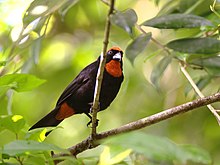Saint Christopher red-headed finch
| Saint Christopher red-headed finch | ||||||||||||
|---|---|---|---|---|---|---|---|---|---|---|---|---|
| Systematics | ||||||||||||
|
||||||||||||
| Scientific name | ||||||||||||
| Pyrrhulagra portoricensis grandis | ||||||||||||
| ( Lawrence , 1881) |
The Saint-Christopher-Rotkopfgimpelfink ( Pyrrhulagra portoricensis grandis , Syn. : Melopyrrha portoricensis grandis , Loxigilla portoricensis grandis ) is an extinct subspecies of Rotkopfgimpelfinks ( Pyrrhulagra portoricensis ) within the family of tanagers (Thraupidae). Some authors see it as a separate species.
features

The Saint Christopher red-headed finch reached a length of 15 cm. The plumage was a single color, dull, shiny black. The top of the head, the throat and the coverts were terracotta in color . The anal area was covered with black spots. The beak, feet and legs were black. In the juvenile birds, the crown, the area above the eyes and the throat were interspersed with a few red feathers. The underside was brownish-beige with a cinnamon tint. The tail feathers were dark gray. The back and rump were brownish with a reddish-olive tinge. There was a pronounced stain on the upper chest. The Saint Christopher red-headed finch was larger and shinier than the nominate form of the red-headed finch.
Occurrence and sympatry
Storrs Lovejoy Olson suggests that the Saint Christopher red-headed finch was found in the past not only on St. Kitts (formerly Saint Christopher) but elsewhere in the St. Kitts and Nevis archipelago , including the islands of Nevis and St. Eustatius , the were associated with St. Kitts due to the low sea level during the last Ice Age. Although no subfossil material of the Saint Christopher red-headed yellow-headed finch of Nevis and St. Eustatius is known, Olson's assumption was apparently confirmed after a rostrum of this or a closely related taxon was unearthed in a fossil deposit on Barbuda . Olson also suggests that the limited occurrence of the Saint Christopher red-headed finch in the mountain forests was an adaptation to habitat degradation in the lowland forests. The bearded ringfish ( Loxigilla noctis ) became native to St. Kitts sometime in the late 19th century, where it inhabits the lowland forest belt, while the Saint Christopher red-headed finch was confined to the mountain forests. Herbert Raffaele's assumption that the presence of the smaller bearded gimp finch had an impact on the population of the Saint Christopher red-headed gimp finch is no longer tenable today. However, the earlier distribution of both taxa on Barbuda shows that both the Saint Christopher red-headed finch and the bearded finch once occurred sympatric in the northern Lesser Antilles .
Way of life
Nothing is known about the way of life of the Saint Christopher red-headed finch. Presumably it was similar to that of the nominate form, which lives secretly in dense forests and feeds on seeds, fruits, insects and spiders as an omnivore.
die out
When Frederick Albion Ober collected the type specimens in May 1880, the breed, which the locals referred to as “Mountain Blacksmith”, was still relatively common on Mount Misery . By 1920 it had almost disappeared and on July 26, 1929 Paul Bartsch collected the last known specimen. The reasons for the disappearance are unclear. The ornithologist James Bond suspected introduced Ethiopian green monkeys ( Chlorocebus aethiops ) as the main cause. However, it can be countered by the fact that a number of other gimp finch cards have survived on other Caribbean islands and that, for example, the Barbados bullfinch ( Loxigilla barbadensis ) coexists with the same species of monkey on Barbados . Ornithologist Herbert Raffaele pointed out that Bond's guess is highly unlikely, given that monkeys have been wild on St. Kitts since the early 18th century. The vervet monkeys had their habitat in the mountain gorges and rarely stayed high in the mountains where the Saint Christopher red-headed finch existed. It therefore seems very unlikely that the monkeys could have caused this breed of gimp finch to become extinct at this late stage. Raffaele, however, suspected two devastating hurricanes that struck St. Kitts in 1899 as the main cause. Although inaccurate, massive deforestation such as occurred on St. Kitts had exacerbated the impact of hurricanes on the island's bird populations and drastically reduced the already declining population of the Saint Christopher red-headed yellowfinch. After search expeditions by Herbert Raffaele (1972), Marvin Ralph Browning (1977) and David William Steadman (1982) were unsuccessful, there is little doubt that this subspecies is actually extinct.
literature
- George Newbold Lawrence: Description of a new subspecies of Loxigilla from the island of St. Christopher , West Indies. In: Proceedings of the United States National Museum, Volume 4, 1881: p. 204-205
- Robert Ridgway: The birds of North and Middle America: A descriptive catalog. Pt. I Family Fringillidae - The Finches In: Bulletin of the United States National Museum. No. 50, 1901: p. 550-551
- Julian Pender Hume, Michael P. Walters: Extinct Birds , pp. 324-325, A&C Black 2012, ISBN 140815725X
Web links
- Photograph of a bellows in the Museum Naturalis Leiden ( Memento from October 27, 2014 in the Internet Archive )
Individual evidence
- ^ A b Garrido, OH, and JW Wiley. 2003 .: The taxonomic status of the Puerto Rican Bullfinch (Loxigilla portoricensis) (Emberizidae) in Puerto Rico and St. Kitts . Ornitologia Neotropical 14: p. 91-98.
- ↑ a b c d Olson, SL (1984): The last St. Kitts Bullfinch Loxigilla portoricensis grandis (Emberizinae) and the extinction of its race In: Bulletin of the British Ornithologists' Club 104 (4): p. 121-123
- ↑ a b Steadman, DW, Norton, RL, Browning, MR & Arendt, WJ (1997): The birds of St Kitts, Lesser Antilles . Caribbean Journal of Science. 33 (1-2): p. 1-20.
- ↑ a b c Raffaele, HA (1977): Comments on the extinction of Loxigilla portoricensis grandis in St. Kitts , Lesser Antilles. Condor 79: p. 389-390
- ↑ James Bond: Check-list of Birds of the West Indies. Waverly Press, 3rd edition, 1950